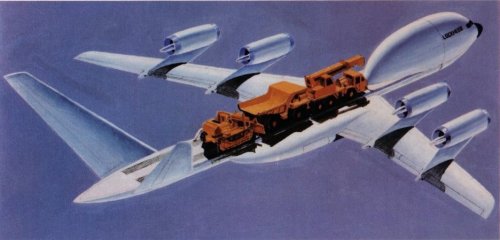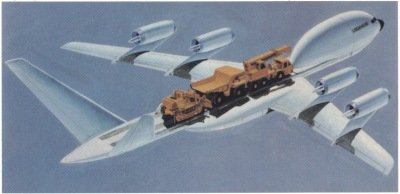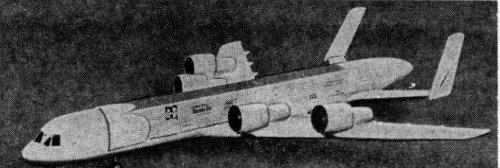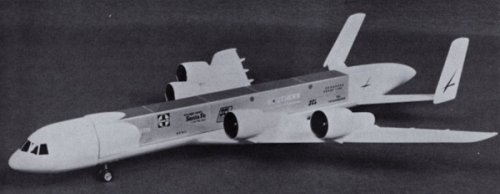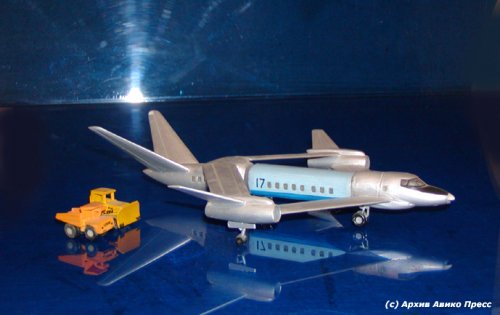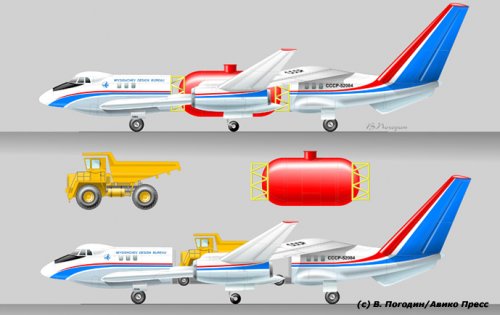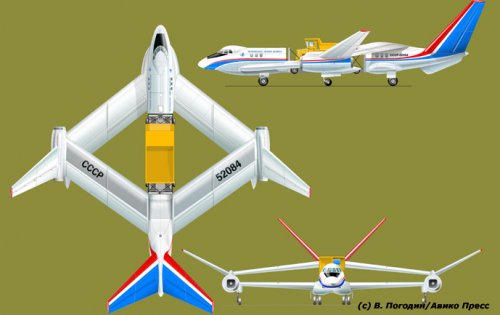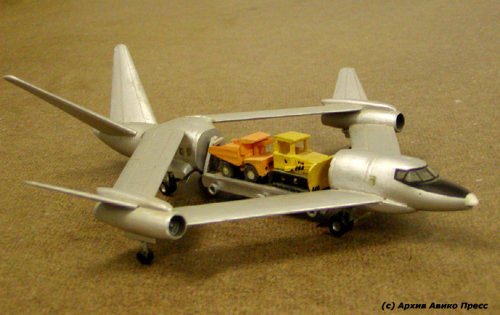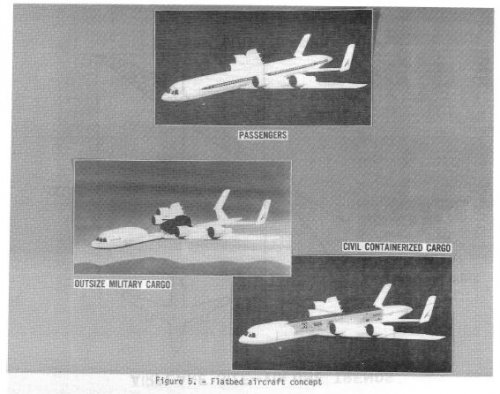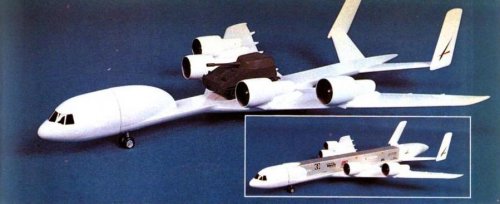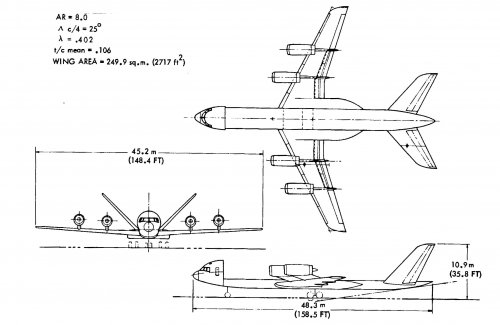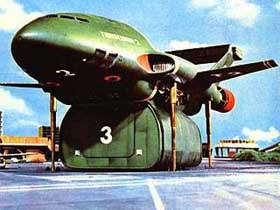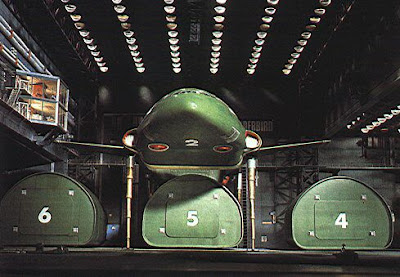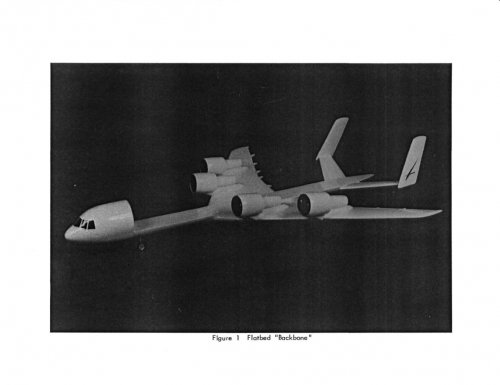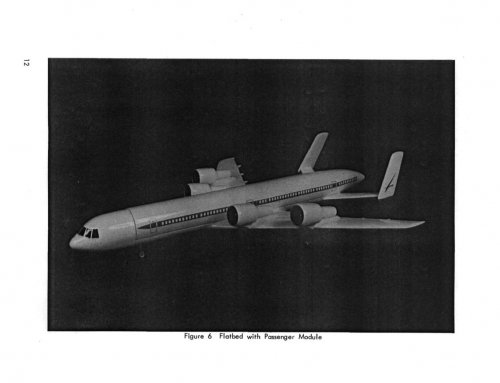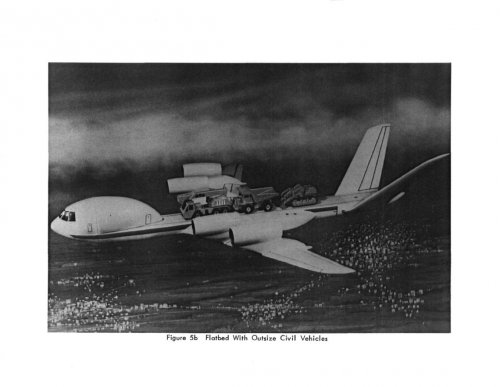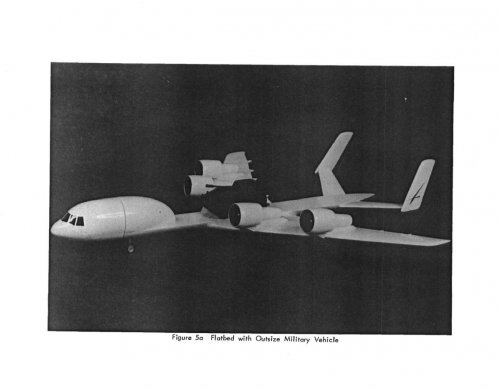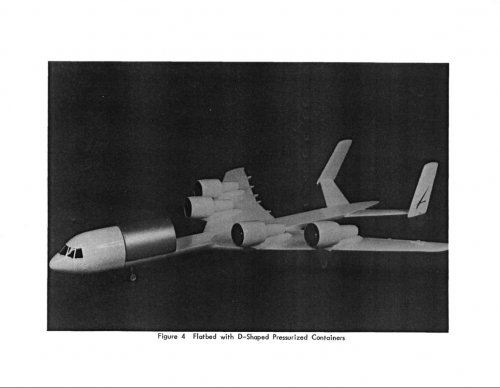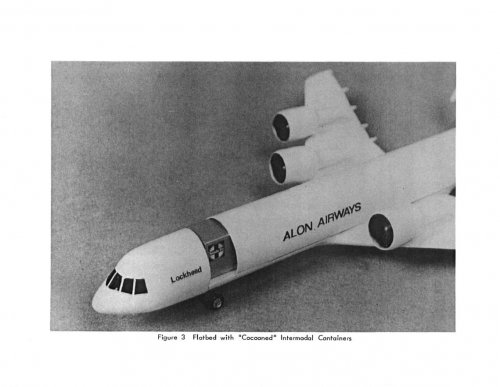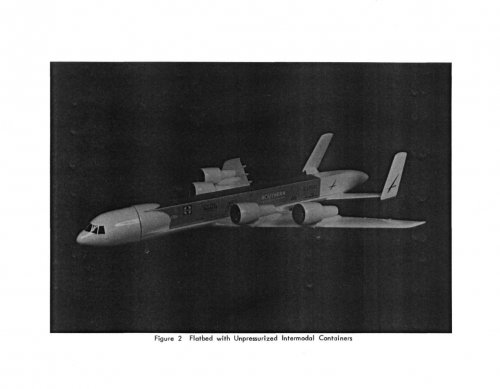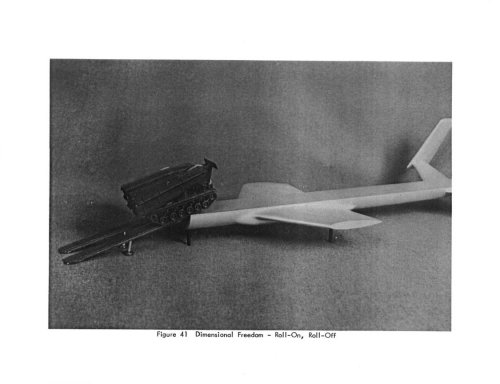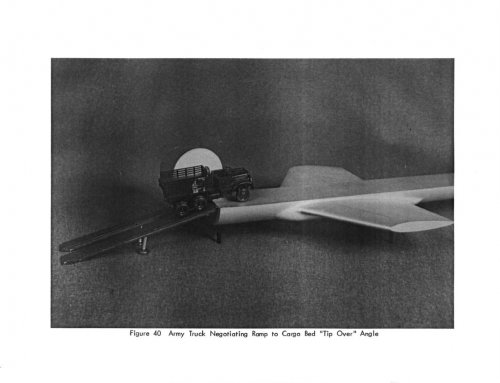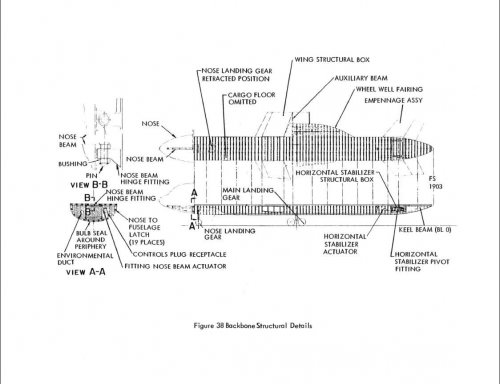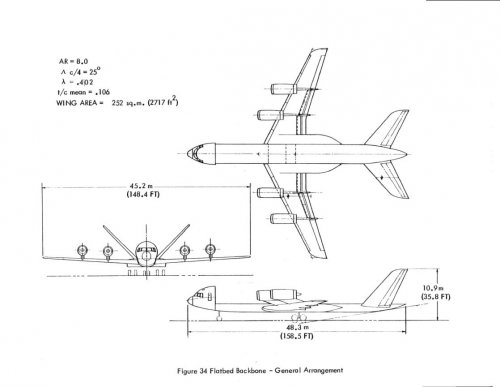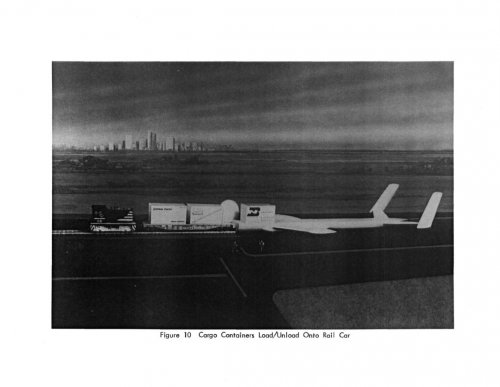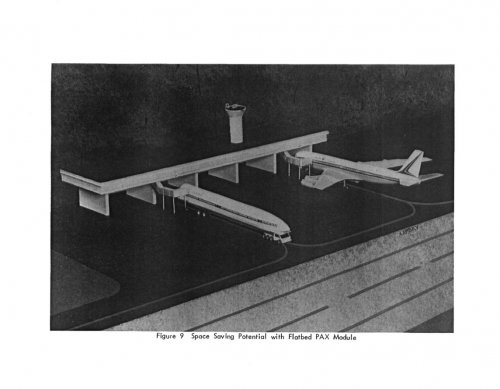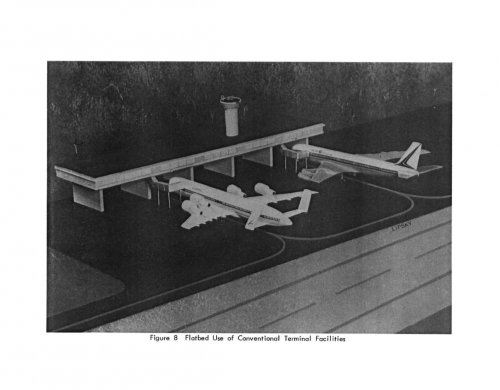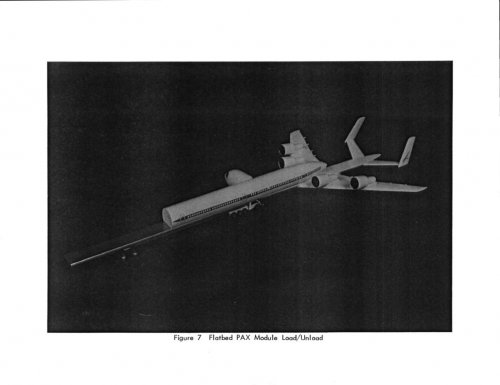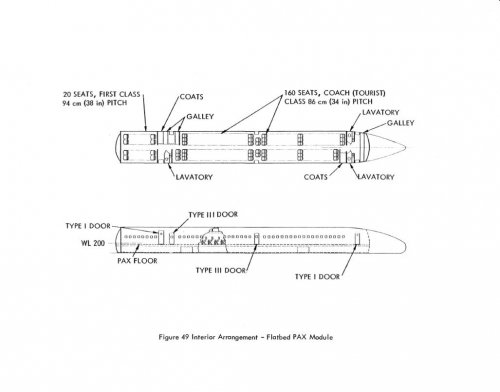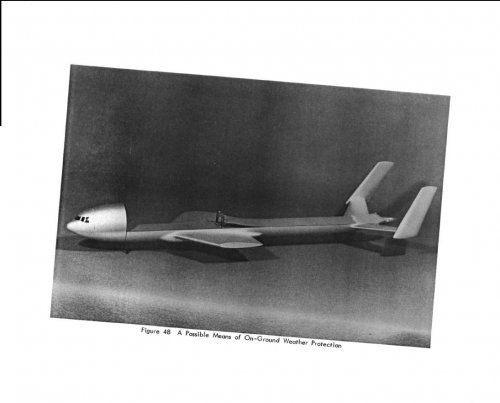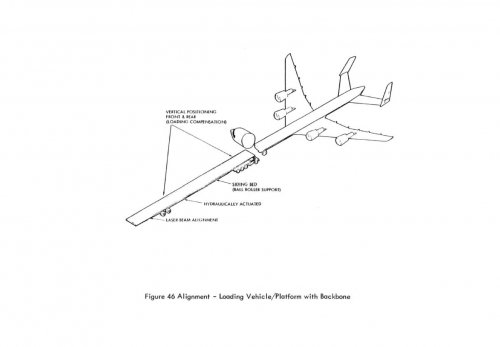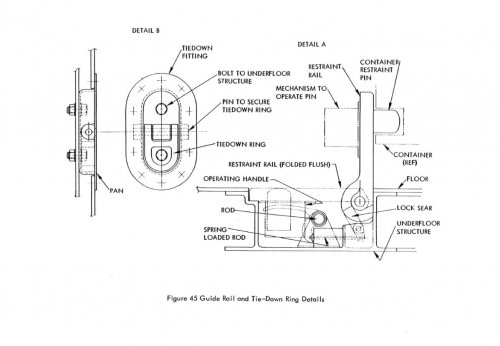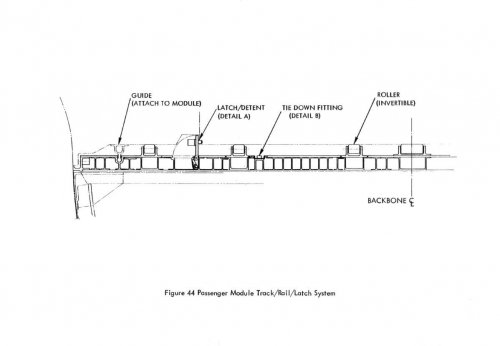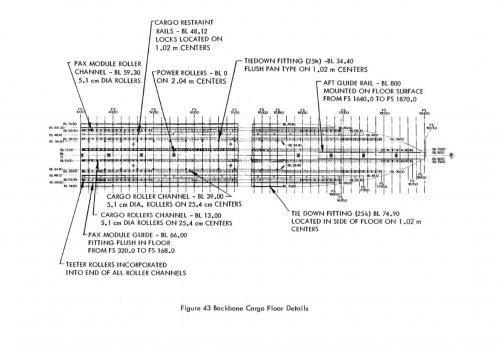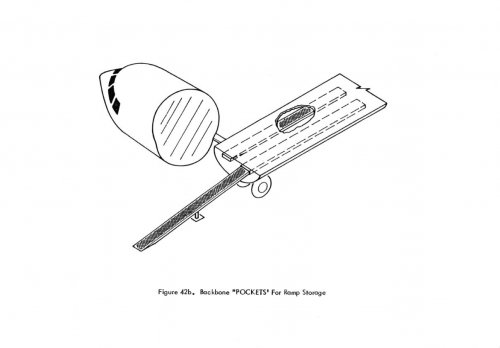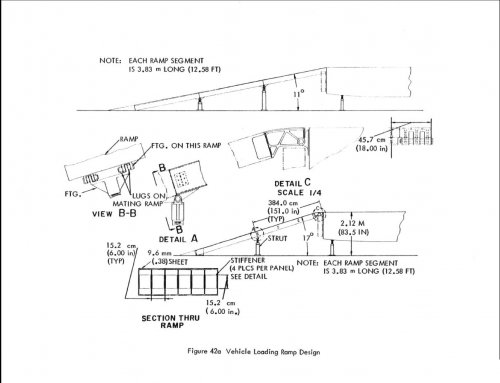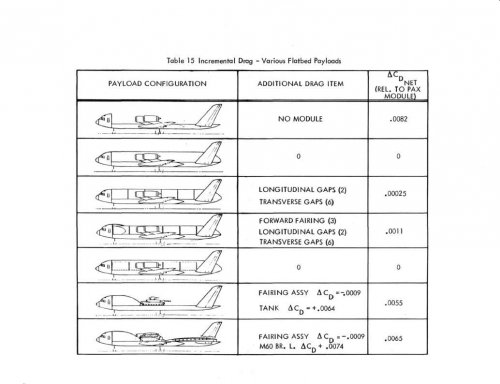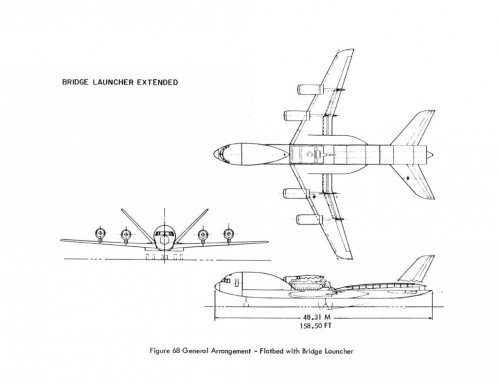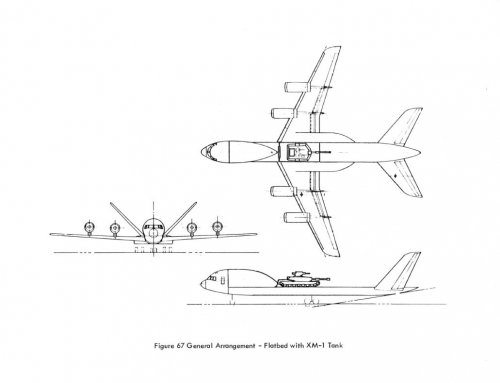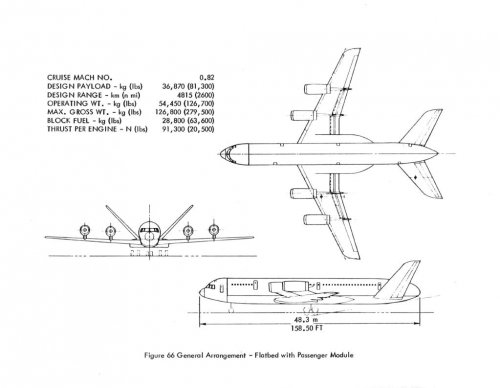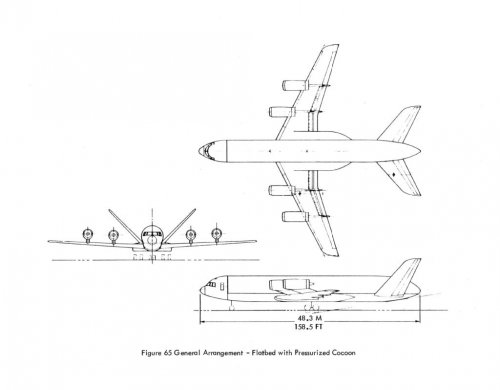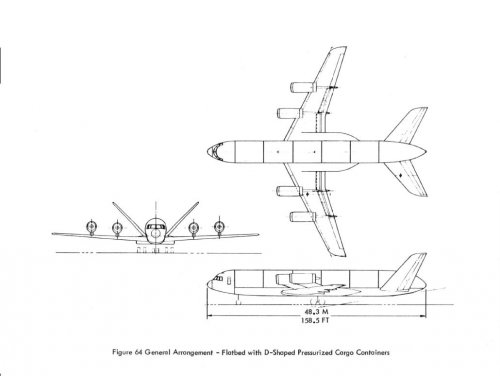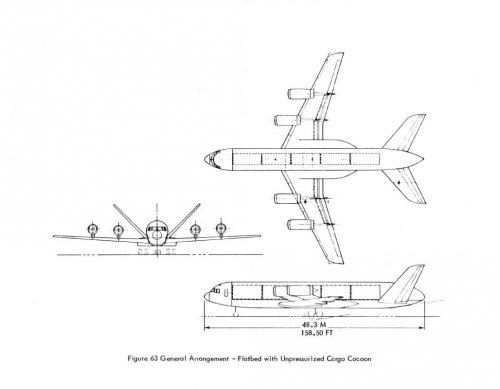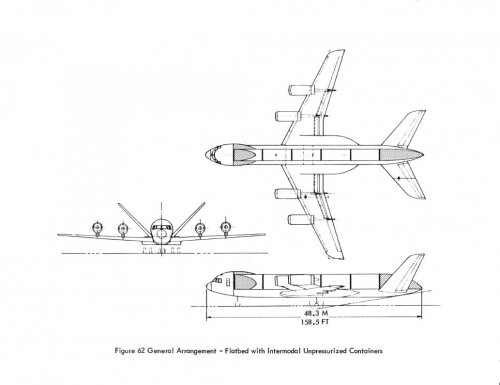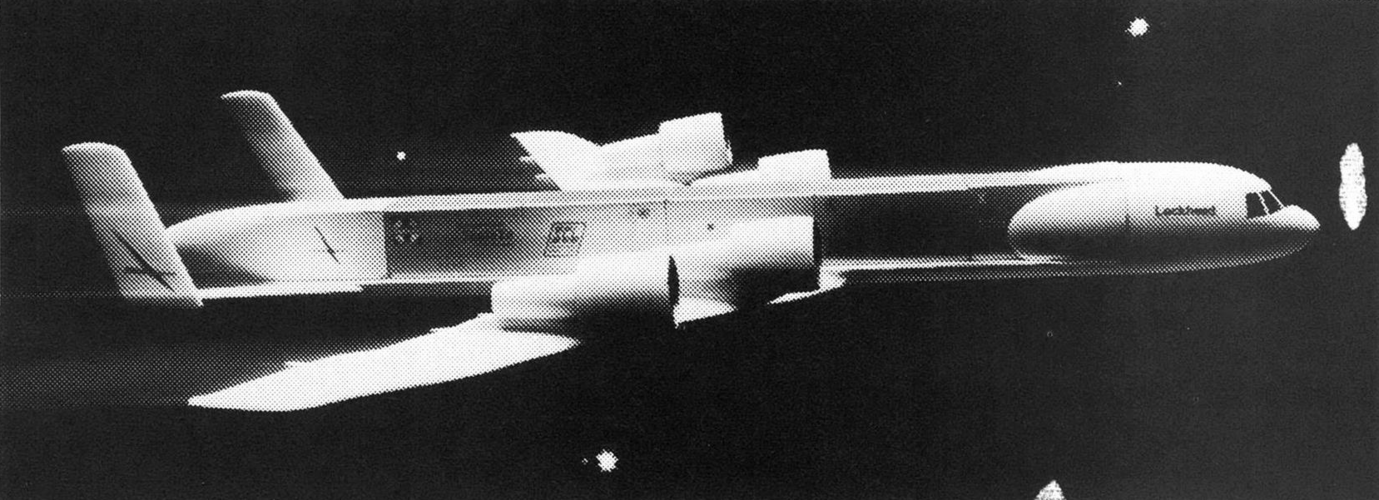You are using an out of date browser. It may not display this or other websites correctly.
You should upgrade or use an alternative browser.
You should upgrade or use an alternative browser.
Lockheed "Flatbed" transport designs
- Thread starter Orionblamblam
- Start date
A late-70's design by Lockheed for how to carry a wide range of unusually sized cargos: get rid of the fuselage, and carry the payload externally. I've sure flying with a bulldozer hanging in the breeze would have been *all* kinds of fun.
More info, including a fat pile of drawings, in the first issue of the new APR at: http://www.up-ship.com/eAPR/index.htm
More info, including a fat pile of drawings, in the first issue of the new APR at: http://www.up-ship.com/eAPR/index.htm
Attachments
- Joined
- 2 August 2006
- Messages
- 3,256
- Reaction score
- 1,529
Cool, I'm so glad I'll have this on disk now, with excellent drawings and color pictures. One vehicle I would love to see you revisit soon with good drawings in the eAPR is the GRM-29. Also, if you have anymore info on the original ATF (Strike aircraft) like those drawings you posted of the Grumman High-Dive concept would be excellent as well.
Anyway, I've already sent money for two subscriptions, one for me and one for one of my friends.
Thanks. 8)
Anyway, I've already sent money for two subscriptions, one for me and one for one of my friends.
Thanks. 8)
Sundog said:One vehicle I would love to see you revisit soon with good drawings in the eAPR is the GRM-29.
One additional change that will be coming along for future issues is that, like the Bomber Projects book, I will make some new drawings. This should help clear up a few things, and the GRM-29 is one that will get drawings. Didn't do that for anything in eV1N1, as the drawings were all pretty clear. But the thought did occur to do a side-view of every design in the issue, and show them all to scale...
[/quote]
Maveric
Fight for yor Right!
- Joined
- 14 January 2007
- Messages
- 2,232
- Reaction score
- 855
- Joined
- 14 June 2006
- Messages
- 2,300
- Reaction score
- 561
There is a rich NASA CR- report on this, but still unavailable online. Moreover, Lockheed-Georgia did a very extensive series of studies, some with NASA funding, some not, on which the press at the end of 1979 published a lot. It seems that journalist that went to NABA '79 were invited to visit Lockheed-Georgia in Marietta and came back with tons of material (BTW, the very same people went to Grumman, and came back with another ton of paper). If someone can reach someone of them... One is Marc Granger, who published a fairly extensive article on Interavia 12/1979, promising another one on even more advanced concepts he saw, but never appeared... Anyone knows Marc Granger ? Or another of the journalists who went to NABA '79 ?
- Joined
- 27 December 2005
- Messages
- 17,753
- Reaction score
- 26,468
- Joined
- 4 May 2008
- Messages
- 2,439
- Reaction score
- 762
I was wondering what was the point of making this thing turbofan powered. How fast were they planning to go with a Bulldozer hanging in the wind anyway? Since the engines are mounted on upside down pylons above the wing, there is probably enough room for turboprops.
Does anyone know?
Does anyone know?
Hi to all!
There was soviet equivalent of Lockheed "Flatbed" transport - "Romb" project in Myasishchev DB.
More info see in www.avicopress.ru
Regards
There was soviet equivalent of Lockheed "Flatbed" transport - "Romb" project in Myasishchev DB.
More info see in www.avicopress.ru
Regards
Attachments
- Joined
- 17 October 2006
- Messages
- 2,393
- Reaction score
- 1,198
Is good vodka. Georgia moonshine, also good!
ucon said:Hi to all!
There was soviet equivalent of Lockheed "Flatbed" transport - "Romb" project in Myasishchev DB.
OK, that design is all kinds of crazy... and jam-packed full of AWESOME.
- Joined
- 1 April 2006
- Messages
- 11,401
- Reaction score
- 10,327
last edition was published in 2005 and sold out *totally here*, but updated re-issue is quite possible nearest years according to Konstantin Udalov
you can contact him regarding this directly at ucon-2000@mail.ru
AFAIR, 'Romb' wasn't in last edition yet - this is one of almost hudred Myasishchev projects that were discovered recently
you can contact him regarding this directly at ucon-2000@mail.ru
AFAIR, 'Romb' wasn't in last edition yet - this is one of almost hudred Myasishchev projects that were discovered recently
- Joined
- 14 June 2006
- Messages
- 2,300
- Reaction score
- 561
Crane ?Does the book say how they were going to load it?
And, thanks Gregory, I'll follow the trek
- Joined
- 1 April 2006
- Messages
- 11,401
- Reaction score
- 10,327
AeroFranz said:Does the book say how they were going to load it?
More info for registered users here http://avicopress.ru/plane.php?id=284
Cargo was moved from the back under the rear pair of wings on mobile powered multi-wheel platform (that was at the same time carry trough lower structure of the fuselage between its two 'halves'), then positioned below the 'breach' and lifted up via built-in elevators.
Kind of Galaxy cargo floor travelling on its own across the airfield collecting M1s and then mating back with the bird.
- Joined
- 4 May 2008
- Messages
- 2,439
- Reaction score
- 762
flateric said:Cargo was moved from the back under the rear pair of wings on mobile powered multi-wheel platform (that was at the same time carry trough lower structure of the fuselage between its two 'halves'), then positioned below the 'breach' and lifted up via built-in elevators.
Kind of Galaxy cargo floor travelling on its own across the airfield collecting M1s and then mating back with the bird.
I wonder how many stress analysts at Myasishchev OKB threatened to commit suicide!
- Joined
- 26 May 2006
- Messages
- 34,922
- Reaction score
- 15,794
Hi,
the flatbed concepts.
the flatbed concepts.
Attachments
V8Interceptor
ACCESS: Restricted
- Joined
- 3 March 2009
- Messages
- 30
- Reaction score
- 3
Where Lockheed the only manufacturer proposing this concept? I swear I remember seeing a model of an MD DC-10 based "flatbed" years ago in one of the POPULAR (Science or Mechanics) magazines. Maybe it was L-10-11 based, it obv. would have had the drawback of having to be top loaded due to the conventional tail/engine configuration...
Color images of Lockheed "Flatbed" concept model.
Source: "New-Technology Monster Transports Will Dwarf Today's Jumbo Jets" by Ben Kovicar, Popular Science, October 1980.
Flat-bed transports could airlift outsize military or civilian cargo. This NASA-sponsored Lockheed-Georgia design has a level loading surface close to the ground. Tanks, such as the 118,500 lb. XMI, or other such cargo could roll on and off. In flight, they would be lashed down, and hauled exposed. A half-cylinder pressurized module could adapt the transport for passenger or freight operation. Or containerized cargo could be loaded aboard and covered with a thin cocoon to provide an aerodynamic fairing.
Source: "New-Technology Monster Transports Will Dwarf Today's Jumbo Jets" by Ben Kovicar, Popular Science, October 1980.
Attachments
taildragger
You can count on me - I won a contest
- Joined
- 2 November 2008
- Messages
- 404
- Reaction score
- 502
May be I'm missing something but the whole flatbed concept seems flawed to me and I'm surprised it's seen so much study over the years. The possible advantages don't seem to hold water:
Ease of Loading - OK, so you don't have to maneuver cargo inside an aluminum tube - you just have to prepare it for exposure to jet-speed airflows.
Weight Saving - A semi-monocoque fuselage is a pretty efficient structure. The elimination of most of the fuselage envelope would concentrate loads into the much smaller flatbed structure which would have to be correspondingly beefed up. I doubt that much, if any, weight would be saved.
Drag Reduction when Unloaded - The elimination of most of the fuselage means less whetted area, but the transition from cockpit section to flatbed in most of these designs looks draggy. I doubt that they would have significantly less drag than a conventional configuration.
The disadvantages seem more significant:
Aerodynamics - Since the cargo becomes part of the aircraft exterior, wouldn't flight characteristics change with each cargo configuration? Wouldn't testing be required for each?
Cargo Integrity - Unless all cargo is built, maintained and inspected to aircraft standards, there'd be a constant danger of pieces flying off. If you can only carry what are essentially airplane parts, whats the point?
Drag - Almost anything loaded in this fashion would be draggier than a conventional fuselage. For that reason, I don't think the flatbed would offer an advantage in terms of outsized cargo.
Taildragger
Ease of Loading - OK, so you don't have to maneuver cargo inside an aluminum tube - you just have to prepare it for exposure to jet-speed airflows.
Weight Saving - A semi-monocoque fuselage is a pretty efficient structure. The elimination of most of the fuselage envelope would concentrate loads into the much smaller flatbed structure which would have to be correspondingly beefed up. I doubt that much, if any, weight would be saved.
Drag Reduction when Unloaded - The elimination of most of the fuselage means less whetted area, but the transition from cockpit section to flatbed in most of these designs looks draggy. I doubt that they would have significantly less drag than a conventional configuration.
The disadvantages seem more significant:
Aerodynamics - Since the cargo becomes part of the aircraft exterior, wouldn't flight characteristics change with each cargo configuration? Wouldn't testing be required for each?
Cargo Integrity - Unless all cargo is built, maintained and inspected to aircraft standards, there'd be a constant danger of pieces flying off. If you can only carry what are essentially airplane parts, whats the point?
Drag - Almost anything loaded in this fashion would be draggier than a conventional fuselage. For that reason, I don't think the flatbed would offer an advantage in terms of outsized cargo.
Taildragger
- Joined
- 25 June 2009
- Messages
- 14,758
- Reaction score
- 6,161
taildragger said:May be I'm missing something but the whole flatbed concept seems flawed to me and I'm surprised it's seen so much study over the years. The possible advantages don't seem to hold water
I think you have aptly summed up the flaws of the design. I have always asked the same questions myself, especially the question of drag inherent to the abrupt gap aft of the nose section and the dubious aerodynamics resulting from various types of loaded material. This would be less of a problem at slower speeds, but if the goal of such a transport aircraft is to quickly carry tactical material to combat areas, you want this to be done fast. Besides, showing what you carry in the open air is a dead giveaway for foreign spy satellites... Really wonder what possessed Lockheed designers over this one!
- Joined
- 14 June 2006
- Messages
- 2,300
- Reaction score
- 561
Well, the open carriage of very large equipment were only one of the possibilities... and the more extreme. The general idea was to use cargo pods. In this, the flatbed concept is a variation of the various pod-carrying planes proposed over the years (XC-120, Miles, SM-105, etc.). And the arguments against podded cargo are more operational (added cost for pods) than techical.
Matej
Multiuniversal creator
Pods sounds much usefull. I am sure that there are not many bulldozers, optimised for the 800 km/h cruise speed 
Smethers, R. G.; Caldwell, E. W.; Warnock, W. E.; Wilson, J. M., Jr. Study of an Advanced Transport Airplane Design Concept Known as 'Flatbed' Marietta. Lockheed-Georgia Company Oct 1, 1980
 ntrs.nasa.gov
ntrs.nasa.gov
SUMMARY:
Study of an advanced transport airplane design concept known as Flatbed - NASA Technical Reports Server (NTRS)
The design concept and configuration of the Flatbed transport aircraft are presented. The Flatbed configuration combines into one frame, the ability to haul cargo, virtually unrestrained by cross sectional dimensions of the fuselage. The feasibility and capability of the Flatbed is discussed in...
SUMMARY:
FLATBED is a unique aircraft configurational concept (derived by Lockheed-Georgia Company) featuring versatility of payloads which are carried on an open cargo floor - there is no fuselage per se. Flatbed can haul containers, passengers in a removable module, or cargoes and vehicles. Large Army vehicles (tanks and bridge launchers) are literally "carried in the open."
Early assessments of the unusual aspects of the Flatbed concept indicated (a) potential problem areas related to specific technical design details and (b) general concerns related to the overall viability of the concept. Hence, a study was undertaken to assess the feasibility, capability, and economic merit of Flatbed. Such a study has
been accomplished through a non-parametric refinement of a point design. Aspects of the study included refinement of the Flatbed configuration and derivation of three reference aircraft (passenger, cargo, and outsize cargo) for purposes of comparison. The study involved smoke flow studies, optimization of a medium sized aircraft for a range of 4815 km (2600 n.mi.), estimation of weights and performance, prediction of acquisition and operating costs, and recommendations for additional areas of technical study.
Refinement of the basic Flatbed concept produced a low-winged vehicle weighing 57209 kg (123,429 Ibs.), optimized for cruise speed for the passenger role at M = 0.82 at 10,688m (35,000 ft.). Features include a pressurized cockpit section internally hinged to pivot to starboard for front-loading of cargo. A Vee tail was determined to present the best compromise of drag and weight. Four engines are mounted on pylons above the wing in order to permit the cargo floor to be as low as possible to the ground (2.12m or 83.5 in.). The cargo floor is fitted with roller-rail-track guide systems, powered rollers, and compatible fittings on the passenger and pressurized cargo modules.
Study results indicate the Flatbed concept to be viable from a technical viewpoint. The only unusual structural area relates to provision for adequate stiffness in the fuselage aftbody. In aerodynamic terms, the design process has produced a relatively smaller aircraft to accomplish the specified missions because of a lighter weight fuselage and
lesser systems weight.
High altitude cruise speed with either unpressurized or pressurized containers is M = 0.82, which is comparable to conventional passenger type airlines hauling cargo and cargo aircraft such as the C-141 or C-5A. The cruise speeds with outsize military vehicles are above M = 0.5 with ranges compatible with the longest distance required without refueling, 4473m (2415 n<,mi.).
It is specifically noted that Flatbed with the passenger module consumes 11 percent more fuel than a conventional passenger airliner and 14 percent more than an outsize military cargo aircraft. Conversely, Flatbed consumes 6 percent less fuel carrying unpressurized cargo in a cocoon and 8 percent less carrying pressurized cargo — relative to conventionally configured cargo aircraft.
In loadability terms, the 2.12m (83.5 in.) cargo floor height of the Flatbed design is sufficiently low to accommodate loading of containers and roll-on, roll-off of vehicle(s). The lack of dimensional restrictions permits use of shorter and lesser weight ramps (17 degrees vis-a-vis 11 degrees) in comparison with conventional designs. Cargo loading, tie-down, and guide systems appear to be adequate since they are of conventional design. In economic terms, the Flatbed backbone acquisition costs are lower than any of the reference aircraft,, This results, partially, because the RDT&E costs are about 3 percent lower than a comparable conventional cargo airplane, 18 percent lower than an
outsize cargo airplane, and 9 percent lower than a conventional passenger airplane. In the latter case, however, the added RDT&E costs of the passenger module net the Flatbed passenger version about 25 percent higher. Unit production costs of Flatbed, for a comparable production run, are about $1 million lower than a conventional cargo airplane, and $2 million lower than a passenger airliner.
Flatbed DOC's vary between 8 and 26 percent lower than conventional cargo airplanes as a function of production run. (Three cases of varying production runs of Flatbed and the reference airplanes were specified for analysis.) Military life cycle costs are over 30 percent lower than a conventional outsize aircraft. The passenger seat-mile costs
are essentially equal to a conventional airplane except for QC operations which are about 8 percent lower for Flatbed.
Recommendations for additional studies include wind-tunnel tests (particularly of vehicular hauls), possible use of a metal matrix aftbody, and both military and commercial cargo airline operations in realistic scenarios.
Attachments
Last edited by a moderator:
Smethers, R. G.; Caldwell, E. W.; Warnock, W. E.; Wilson, J. M., Jr. Study of an Advanced Transport Airplane Design Concept Known as 'Flatbed' Marietta. Lockheed-Georgia Company Oct 1, 1980
Attachments
Smethers, R. G.; Caldwell, E. W.; Warnock, W. E.; Wilson, J. M., Jr. Study of an Advanced Transport Airplane Design Concept Known as 'Flatbed' Marietta. Lockheed-Georgia Company Oct 1, 1980
Attachments
Smethers, R. G.; Caldwell, E. W.; Warnock, W. E.; Wilson, J. M., Jr. Study of an Advanced Transport Airplane Design Concept Known as 'Flatbed' Marietta. Lockheed-Georgia Company Oct 1, 1980
Attachments
Does the fuselage and fairing assembly adequately protect the load on the flatbed? Or would the crane and the dump truck in the artist's impression arrive with body damage and/or shattered windshields?
- Joined
- 11 March 2006
- Messages
- 8,625
- Reaction score
- 3,808
Had similar thoughts, when I saw this concept for the first time. I think, the fairing behind
the cockpit may act as a spoiler or windshield, leading the airflow around the load and so
reducing aerodynamic pressure. You can drive in a drop-top, too, without the full airstream
in your face.
the cockpit may act as a spoiler or windshield, leading the airflow around the load and so
reducing aerodynamic pressure. You can drive in a drop-top, too, without the full airstream
in your face.
Zeppelin
ACCESS: Confidential
- Joined
- 28 May 2009
- Messages
- 87
- Reaction score
- 30
It seems to me that the concept would also require some specialised loading facilities in the form of ramps and loading cranes. way more expensive kit than the standard way Hercules, Globemaster and Galaxy deliver their cargo.
Anyone look to a flatbed concept for—if not TSTO—orbiter ferry?
Staggering landing gear to drive on the flatbed…then re-affix the tail?
Like trucks, the flatbed is backed up to a dock.
Trailers often have telescoping strut in the nose by the reefer unit.
Several of those could pass the load from a segmented removable ramp directly to the tarmac—without the airframe “feeling” the weight while rolling…which would doubtless be stressful.
Once your payload is seated and evenly distributed, you remove ramp sections and let the load gradually rest upon the plane’s landing gear…and extract the “legs” from holes and button it up.
The goal is to baby the wingbox as much as you can…
Now, wings flex…the whole plane does. A front-end loader frame has no give. Could ground equipment cause a “pinch” or bind…or could earthmoving equipment itself be built by the plane manufacturer such that the equipment helps become the plane’s backbone in flight?
The rolling on and off of dense equipment—especially forklifts—that’s what breaks things.
BTW if we ever have heavy equipment on the Moon—drive slow…the mass is still there even if some of the weight isn’t, and your load will pull you right over if you try to stop too quick.
Staggering landing gear to drive on the flatbed…then re-affix the tail?
Like trucks, the flatbed is backed up to a dock.
Trailers often have telescoping strut in the nose by the reefer unit.
Several of those could pass the load from a segmented removable ramp directly to the tarmac—without the airframe “feeling” the weight while rolling…which would doubtless be stressful.
Once your payload is seated and evenly distributed, you remove ramp sections and let the load gradually rest upon the plane’s landing gear…and extract the “legs” from holes and button it up.
The goal is to baby the wingbox as much as you can…
Now, wings flex…the whole plane does. A front-end loader frame has no give. Could ground equipment cause a “pinch” or bind…or could earthmoving equipment itself be built by the plane manufacturer such that the equipment helps become the plane’s backbone in flight?
The rolling on and off of dense equipment—especially forklifts—that’s what breaks things.
BTW if we ever have heavy equipment on the Moon—drive slow…the mass is still there even if some of the weight isn’t, and your load will pull you right over if you try to stop too quick.
Last edited:
Similar threads
-
-
-
Lockheed Civil Transport Aircraft Projects
- Started by hesham
- Replies: 9
-
Aerospace Projects Review individual articles available
- Started by Orionblamblam
- Replies: 0
-
Lockheed WIG transport aircraft studies
- Started by flateric
- Replies: 30

